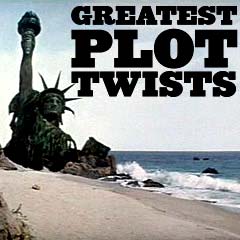
|
|
|
||||||||||||||||||||

|
Haunted (1995, UK)
This R-rated, poorly-received haunted house mystery drama (similar to Henry James' The Turn of the Screw) was directed by Lewis Gilbert from an adaptation of James Herbert's novel of the same name. Its tagline was unconvincing:
The film's twist about a ghostly presence came years before two other more prominent films with similar endings: The Sixth Sense (1999) and The Others (2001). Executive-produced by Francis Ford Coppola, it was only released on DVD following star Kate Beckinsale's later prominence, in films such as Pearl Harbor (2001). The film opened with an earlier traumatic incident for the film's main character:
Years earlier in Sussex, England in 1905, he had pushed his twin sister Juliet Ash (Victoria Shalet) during innocent horseplay when he was an 11 year-old child. She was knocked unconscious when her head hit a rock, rolled over into a body of water, and sank to the bottom. It was ruled an accidental drowning. When her body was displayed in a coffin in the family living room, one night David was summoned to the edge of her casket, and her eyes suddenly opened after he kissed her forehead - and he screamed!. Now, in the present year of 1928, David was still guilt-ridden about Juliet's death. Because of his fame as a popular book author about psychic phenomenon, David - who vehemently didn't believe in ghosts and thought seances were suspect - was called upon to investigate the supposed 'haunting' of the upper-class Webb's family country estate (Edbrook Manor) in England by tormented spirits. The Sussex estate was inhabited by elderly maid Nanny Tess Webb (Anna Massey), a mentally-troubled frail old woman who had been the Nanny for the three Mariell siblings, now adults and living there:
In the midst of trying to debunk ideas of the supernatural (he was against spiritualists and mediums), David began to believe that the elderly Nanny was suffering from madness, wild imaginations and senile hallucinations, when she declared: "There are spirits in this house." When he first arrived, he met Christina at the train station (emerging from plumes of steam) who stated that the siblings had actually invited him - and then warned:
David soon observed the pseudo-incestuous behavior between Christina and both of her brothers. She often appeared nakedly indifferent (posing nude for her brother's painting, skinny-dipping by diving off a dock, etc.).
Robert described Christina's nude portrait that he was painting: "At its best, it captures the soul of both painter and subject. Makes them both immortal." A romance blossomed between David and Christina and he was eventually able to bed down Christina himself. During his stay, there were ghostly sightings of Christina's dead mother, and David also had troubling visions of his own: flashbacks to his sister's drowning and appearances of her, a fire in the estate's hallway, and the sighting of a mysterious spiraling column of dust leading him to the dock. In the film's twist ending, it was discovered that the house was frozen in time. The three Mariell siblings were all ghosts, actually bored reprobates, who were tormenting the maid (their childhood nanny). As confirmation, David was led by the ghostly vision of sister Juliet to the graveyard where he viewed the tombstones of the three Mariells, who died in 1923 in a house fire (set by Nanny). The Nanny had set the fire that had killed them in one of the locked bedrooms, after their distressed mother had committed suicide (by drowning), upon learning of the siblings' incest. After killing the Nanny (the ghosts didn't need her anymore), the three attempted to have David kill himself and join them (Christina urged: "Die for me, David"), by tricking him into jumping from a window to his death after they set the mansion ablaze. He was able to escape from the haunted, burning mansion when saved and led away to safety by the ghost of his dead sister Juliet. As she took his hand, the fiery inferno around them abruptly stopped and she guided him away from the burned-out ruins. He gratefully thanked her: "I'll never forgive myself for what happened to you." She replied that he was forgiven and absolved: "It wasn't your fault, David. It was an accident." He thought: "We would have been so close." She assured: "And we always will be. Goodbye, David." After hugging, she walked off and slowly vanished - into the afterlife?
But upon his return home as he stepped off the train at a station, he was greeted by his assistant Kate (Geraldine Somerville), who hugged him and ironically asked: "David, welcome home. Did you scare all the ghosts away?" He chuckled: "Most of them." Behind them as they walked away, emerging from the fog and steam, was the figure of Christina - still following and stalking after him. |
 Juliet Ash Falling and Hitting Forehead on Rock  Juliet's Drowning  Juliet in Casket  Christina Mariell (Kate Beckinsale)  Painting of Christina  Free-Spirited Christina  Ghostly Sightings  Love-Making  Final Scene: Christina Still Stalking Him? |
||||||||||||||||||

|
Heaven's Gate (1980)
Writer/director Michael Cimino's controversial epic western, a box-office bomb, was loosely a story of the Johnson County War in 1890s Wyoming. After a murderous two-day bloody showdown between the armed European immigrant farmers and the mercenaries hired by an association of wealthy land barons-cattlemen to protect their stock, it appeared the violence was over. However, there were still two more surprising deaths - both shocking ambush murders at Ella Watson's cabin:
The killers were led by black-garbed and evil Frank Canton (Sam Waterston), the head of the Wyoming Stock Growers Association (with support from the cattle barons). Sheriff Jim Averill's (Kris Kristofferson) lost love Ella died in his arms, after he retaliated by killing Canton and his men. In the film's added, almost wordless, despairing coda or epilogue scene, Sheriff Averill - now appearing miserable and unemotional about ten years later, was quietly lost and adrift in his recollections. He was a rich yacht captain off Newport, Rhode Island in 1903 with his wife (his waltz partner in the film's opening scene set at Harvard University in 1870, and the woman in the framed picture he kept with him). |
 Death of Ella Watson in Sheriff Averill's Arms  Epilogue: Sheriff Averill With Waltz Partner |
||||||||||||||||||

|
Hide and Seek (2005)
This creepy thriller by director John Polson was soundly criticized for its illogical and contrived conclusion and for its shifting points of view. It opened with the suicidal death of loving mother Alison Callaway (Amy Irving) after playing a game of 'hide and seek' at bedtime with her daughter. She slit her wrists while in a bathtub surrounded ceremonially by candles in her NYC apartment, at exactly 2:06 am. She seemed to be in a troubled marriage to mild-mannered husband-psychologist Dr. David Callaway (Robert De Niro), and said that things were "beyond therapy" before her death. After her death, David spoke to family friend Katherine (Famke Janssen), Emily's therapist, and was regretful about Alison's suicide: "I should've seen it coming. All the signs were there." To "start over," David decided to move with his traumatized and depressed young 11 year-old daughter Emily (Dakota Fanning) to the small and secluded resort town of Woodland Estates in upstate NY, about an hour's drive away. Soon after, Emily kept talking about her tormented association with an imaginary, invisible friend named "Charlie" - who she first met in a cave in the woods near the house. There were lots of red herrings about the identity of "Charlie" who liked to play the game of Hide and Seek, hated David, and was jealous of Emily's company. Who was Charlie? Was it ---
There were a few lurid reminders of the suicide - i.e., the cat was found drowned in a similar bathtub setting at 2:06 am for which "Charlie" was responsible, with crayon writings on the wall. The plot twist came toward the film's end - David had suffered trauma and pain after his wife's death and developed a split personality. David was the docile side, while "Charlie" was the aggressive and jealous side. As "Charlie," David killed his wife after he had viewed her in a compromising, unfaithful coupling on an upper stairwell at a New Years' Eve party (a recurring nightmare for David). He suffocated her while she slept next to him, and then planted her in the bathtub to make it look like a suicide. There were a few obvious clues to David's menacing schizoid personality:
By the conclusion, David - actually "Charlie" - had thoroughly victimized his daughter. He also committed a few murders:
Then, he spoke to Emily, wondering: "I can't help but sense a certain tension between us. What's the matter? Don't you want to play anymore? Don't you want to have fun? Hmm? You want your daddy back? Is that it? You like him more than me, don't you?" She responded that she knew the truth about his murderous second personality: "You killed Mommy." He covered his face - revealing his bloody knife, and began counting for another game of 'hide and seek': "One, one thousand, Two, one thousand..." When Katherine arrived soon after, "Charlie" viciously pushed her down the basement stairs. She acquired the Sheriff's gun and began stalking him, and trying to locate Emily. Meanwhile, "Charlie" had begun his game of 'hide-and-seek' with Emily, who at first fled to the upstairs, and then outside to a cave in the woods (where she had first met "Charlie"). Katherine, Emily, and "Charlie" all came together in the cave. "Charlie" (pretending to be David) began confessing to Katherine:
After Katherine was assaulted, Emily begged "Charlie" not to hurt her friend ("Don't hurt her...She's my friend...Please, Charlie"). "Charlie" replied: "I thought I was your friend." As Katherine aimed and cocked the gun and spoke: "Hide and seek," she shot him twice and put an end to his rampage. The film was famous for having multiple epilogues - the theatrical one ended with Emily living with Katherine. One of her drawings was of herself with two heads, implying that she was also schizophrenic. |
 'Suicidal' Death of Alison Callaway (Amy Irving)  Daughter Emily (Dakota Fanning)  Katherine (Famke Janssen)  David's Unfaithful Wife  Troubled   Murder of Sheriff Rafferty (Dylan Baker)  David = Murderous "Charlie"   Katherine With Gun - Stalking, Shooting and Killing "Charlie" in the Cave  Emily: "Don't hurt her...She's my friend...Please, Charlie"  Emily's Drawing of Herself (With Two Heads) While Holding Katherine's Hand - Emily Also Had a Split Personality |
||||||||||||||||||

|
High Tension (2003, Fr.) (aka Haute Tension, or Switchblade Romance)
Director Alexandre Aja's low-budget, breakout film was partially dubbed in English for its North American release in 2005. Lionsgate released it with the NC-17 rating (rather than unrated) - due to its homoerotic and gritty horror tale, and graphic violence (some of which was edited or trimmed). The film was later released as R-rated. It contained the same twist found in the popular Fight Club (1999) - a very unreliable, violent narrator with a split personality. In the story, two female law college student friends, during a break, went to Alexia's farm home in the French countryside to study for exams:
In Marie's introductory dream credits sequence (a dream when she was sleeping in the back seat of the car), she described to Alexia (as they drove to the farmhouse) about how she was a slasher who chased herself through the forest ("It wasn't a guy. It was me. That was the weirdest part. It was me running after me")) - a clue and hint to the film's premise. Alexia remarked: "Don't you ever have normal dreams?" In a strange, early sequence in the film, there was a necrophilia-tinged shot of the future brutish killer, a van driver (Philippe Nahon), having sex with a decapitated female head in his lap that he discarded out the window as he drove off. As the serial killer arrived at the farm house, there was an intercut scene of Marie in her bedroom masturbating to the song Runaway Girl by U-Roy with lyrics: "She's just another girl, that's what you are. You are just another girl." She had just spied on her love interest Alexia through an upstairs window as she took a shower. During their first night in the farmhouse, the driver invaded and in a lengthy sequence, ferociously killed the family members. First, he slashed Marie's father and then decapitated him. Marie witnessed most of the bloody murders, and at one time played hide-and-seek with the killer to avoid being detected during the neck-slashing razor murder of her mother. Afterwards, the killer kidnapped a chained and bound Alexia. With a butcher knife in her hand, Marie hid in the back of the nameless killer's blood-stained, rusty van to pursue him and help rescue her kidnapped friend. The action was told from the vantage point of Marie, who was trying to save her friend. The killer proceeded to a gas station where he filled his van with fuel and then murdered the gas station attendant Jimmy (Franck Khalfoun) by axing him in the chest (Marie again witnessed the killing). In the clerk's stolen car, Marie found herself being pursued by the van into the woods. She was badly injured when forced off the road and her car crashed. Marie was eventually able to bludgeon the killer with a fence post covered in barbed wire. As Marie inspected the body, he grabbed at her throat. She retaliated by suffocating him with a plastic sheet. By this time, the police had investigated the gas station clerk's murder, and on surveillance tape, they watched as Marie was shown committing the murder. The film's highly improbable conclusion revealed the gimmicky, reality-shifting, absurdly-surprising "Gotcha" twist that the male killer was in Marie's psychotic, schizophrenic imagination - she was actually the killer of Alex's family as well. Undoubtedly Marie felt homicidal rage for being repeatedly sexually spurned by Alex. Another earlier clue to Marie's split personality was the shot of a doll's face split in two by a large crack. An obscure clue was provided with the Latin saying on the back of Marie's tight T-shirt which read: Audaces Solum (literally "Boldly Alone" or "Very Lonely"). In the conclusion, the male killer (the van driver) with a circular concrete saw chased down Alexia (who had hailed down a passing car), and savagely disemboweled the driver. Alex tried to escape but could not run off, due to a large sliver of glass that had sliced through her Achilles' tendon. And then the male killer was transformed into Marie. The bloodied Marie approached Alexia - and kissed her, proclaiming that she would be her heroic savior: "You really know how to drive a woman crazy, don't ya, ya goddamn bitch!... Do you love me? You don't love me, do you? Nobody will come between us ever again, Alex. Never again." Marie's murderous actions to kill Alexia's family was so that she could obsessively be with her. Alexia resisted the kiss - fought back and plunged a crowbar into Marie's upper-chest - and it emerged from her back.
In the last scene, Marie was institutionalized in a mental hospital (the same images were present in the film's opening when Marie stated: "Are they recording?" - making the entire film her own nightmarish flashback). Marie kept repeating to herself: "I won't let anyone come between us anymore." Alex looked at Marie through a one-way mirror as Marie sensed her presence and gestured with open arms toward her. |
 Opening Dream  A Discarded Decapitated Head After Necrophiliac-Oral Sex with Serial Killer Van Driver  Alexia Showering Upstairs  Marie (Cecile De France) in Her Bedroom - Masturbating   Marie - A Witness to the Murders of Alexia's Family Members in their Farm Home by Van Driver  The Van Driver/Killer  Doll's Face - Schizophrenic Split Hint  Surveillance Videotape of Marie Killing the Gas Station Store Clerk  Marie in Mental Asylum  (Opening Scene) |
||||||||||||||||||

|
A History of Violence (2005)
Canadian director David Cronenberg's crime-thriller told about a happily-married couple (and family) in the small Indiana town of Millbrook:
An attempted robbery in the diner at closing time was foiled by a quick-acting, self-defensive Tom who used a dazzling, ferocious and lethal array of fighting and shooting skills to destroy two "ruthless" drifter criminals, Leland and Billie (Stephen McHattie and Greg Bryk) - Tom even startled himself. [The two had bloodily massacred motel staff members in the opening scene.] Stabbed in the right foot during the assault, Tom was lauded as a "local hero" and "man of few words" - but his past soon came back to haunt him after increased media attention. Irish organized crime mobster Carl Fogarty (Ed Harris) appeared in town in a black sedan with thugs to settle the score, knowing Tom as "Joey Cusack" - a brutal killer from Philadelphia who had left him scarred on his face (from barbed wire) and blind in his left eye. Tom's/Joey's stalking by Fogarty was not easily "over and done with." When followed into the mall, Edie argued with Fogarty: "My husband does not know you. He wouldn't know you, somebody like you." The vengeful mobster shot back: "He knows me intimately." Tom had claimed early in the film to his young six-year old daughter Sarah (Heidi Hayes) that "there's no such thing as monsters," although he was now facing his own past 'monsters'. He had been living a lie for many years. During Fogarty's attempted swap of kidnapped adolescent son Jack (Ashton Holmes) for Tom at the farm-home, Tom dispatched with Fogarty's two men but was shot in the shoulder - after which son Jack killed Fogarty with a shotgun to protect his father. After painfully admitting his violent killer past to Edie as another person named Joey Cusack, Tom suffered strained family relations with his distraught wife. He journeyed to Philadelphia to visit his older brother Richie Cusack (William Hurt), the head of a city crime syndicate, at his Escalade estate. During a tense confrontation, Richie was envious that his brother Joey was "living the American dream" and claimed that disfigured Fogarty and others had taken their anger out on him:
When Richie refused Joey's peace gesture ("I'm here to make peace. Tell me what I gotta do to make things right"), he told Joey point-blank: "You could die, Joey." Richie had ordered his four hitmen to assassinate Joey by garrotting, but he swiftly killed the four thugs and then confronted his brother one final time before fatally shooting him in the head:
The film ended without further dialogue in a dining room table scene involving the entire Stall nuclear family after Tom returned home. The two Stall kids understatedly welcomed their father. Sarah brought a place setting for her dad and Jack moved the main dish platter closer to his father. Edie, still feeling like she was living in a nightmare, shared a painful glance with Tom. |
 Opening Scene: Motel Massacre  Stall Family  Tom Stall (Viggo Mortensen) aka Joey Cusack  Carl Fogarty (Ed Harris)  Son Jack Killing Fogarty With Shotgun  Richie Cusack (William Hurt)  Joey vs. Richie 
Concluding Stall Dining Room Table Scene |
||||||||||||||||||
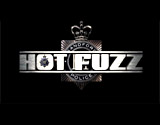
|
Hot Fuzz (2007, UK)
An R-rated, contemporary action police comedy from co-writer/director Edgar Wright, the over-the-top Hollywood-style cop film paired a London officer with a young oafish constable in a sleepy English village. The fish-out-of-water tale deliberately parodied many of the conventions of cop films, such as Dirty Harry, Bullitt, Lethal Weapon, Die Hard, Bad Boys II, Point Break and others, and its tagline stressed the point:
The main character in the inspired send-up was:
He was so efficient, exceptional and competent at his job as a London cop, with a superlative 400% above-average arrest record, that he was incurring jealous wrath from his co-workers. He was made a Sergeant and reluctantly transferred to the bucolic English countryside, to the laid-back rural Gloucestershire town of Sandford ("the safest village in the country"). The ultimate decision had been ordered by Chief Inspector Kenneth (Bill Nighy): "You've been making us all look bad." Angel was told that the town had been honored with the title: "Village of the Year" - for its clean and safe image. In the sleepy town on his first night, the professional policeman arrested a number of underaged boys for drinking at the local pub. He also arrested a drunk driver - a sluggish, dim-witted and chubby Danny Butterman (Nick Frost). After he had taken the inebriated individuals to the station for arrest, the next morning at police headquarters, he was surprised to learn that Danny Butterman would soon be his law-enforcement partner. Danny's father was the kindly, but scheming and widowed Police Inspector Frank Butterman (Jim Broadbent), who urged Angel to overlook indiscretions in the town for "the greater good." Angel also met the other members of the inept police force, and the civilian liaison of Sandford's Neighbourhood Watch Alliance (NWA), including bearded Professor Tom Weaver (Edward Woodward). Weaver exclaimed that the town's 'lawless' elements (including a figure known as The Living Statue) needed to be squashed: "If we don't come down hard on these clowns, we are gonna be up to our balls in jugglers!" To his astonishment, Angel was paired up with Danny, an obsessed aficionado of action-buddy-cop DVD videos. Danny wanted to experience typical action seen in Lethal Weapon, Die Hard, Bad Boys II, Supercop and Point Break ("gun fights, car chases, proper action and s--t...a no-holds barred, adrenaline-fueled thrill ride"), although job-obsessed Angel just wanted to follow the letter of the law. Soon enough, Angel met a few of the town's leaders - members of the NWA (all the members of the town had 'occupation-related' names), including:
The town was similar to the one in The Stepford Wives, with residents constantly providing surveillance via walkie-talkies and closed-circuit video cameras. The uptight, pompous residents of the idyllic village were immediately skeptical of the out-of-towner Angel (they called the "top cop" - "Top Cock") and ridiculed him. With nothing much to do, Angel dealt with an escaped white swan, shoplifting, speeders, illegal hedgerow clippings, unlicensed firearms, and he deactivated a naval sea mine. After a few weeks on the job, hard-nosed cop Angel began to suspect a foul-play murder conspiracy after a series of horrific fatal "accidents" committed by a black-hooded and cloaked slasher. It began with a car crash that beheaded its two occupants. Angel believed that the sinister NWA (and its hooded individuals) was eliminating those it considered a "problem" - those residents who might change the town with plans to develop a large shopping center ("a retail park"), and a proposed Sandford Bypass road. For "the greater good," the conspiracy was fueled by the desire to keep the honor of the town's "Best Village" award. Seemingly, Police Inspector Butterman had appointed himself as "judge, jury, and executioner." In particular, Angel suspected Simon Skinner as the lead assassin, and then he was attacked in his hotel room by Michael "Lurch" Armstrong (Rory McCann), the trolley boy at Skinner's supermarket - sent by Skinner as the hooded killer to murder him. Angel confronted the entire hooded group of town leaders seated in a circle at the town's castle, and as he was pursued by them, he discovered multiple corpses - evidence of the murders of problematic townsfolk. Then, he fled the town to save his life. Determined to launch an all-out assault upon the town's leaders, Angel returned to face a serious gun-battle skirmish with its armed citizens (with Danny's support) in the streets, and then inside the supermarket, after which:
The film ended simply, one year later, with the two having decided to remain, to continue policing the town of crimes (Angel: "I kinda like it here"). Danny had been promoted to Sergeant and Angel was the Chief Inspector of the Sandford Police Service. |
  Partners Nicholas Angel (Simon Pegg) and Danny Butterman (Nick Frost)  Simon Skinner (Timothy Dalton)  Danny Butterman (Nick Frost)  Nicholas Angel (Simon Pegg)  Simon Skinner (Timothy Dalton) - the Hooded Assassin?  and Michael ("Lurch")  Police Inspector Frank Butterman (Jim Broadbent)  The Final Assault |
||||||||||||||||||

|
The Hound of the Baskervilles (1939)
This classic film adaptation of Arthur Conan Doyle's novel of the same name featured the world famous detective Sherlock Holmes. This 1939 film was the first of 14 films with the duo of Sherlock Holmes (Basil Rathbone) and Dr. Watson (Nigel Bruce) as a detective pairing. [Note: It was the first of two 20th Century Fox films, of the 14 films, featuring Rathbone and Bruce in the lead roles.]
The tale has been seen in many versions, including:
It opened in 1889 with a downbeat message:
Following the preface was the death of Sir Charles Baskerville (Ian MacLaren), apparently of a heart attack, just after a baying hound was heard. The victim was running through the moors, then clutched his chest, and fell dead to the ground. There was a long-standing legendary curse that Baskerville family members were being murdered by a demonic dog, stretching back to Sir Hugo Baskerville (Ralph Forbes), who was killed in 1650 (seen in flashback): "His body literally torn to shreds." Ultimately, the culprit behind the latest deadly attempts on Baskervilles was local naturalist John Stapleton (Morton Lowry), who was a distant relative (long lost cousin) of the Baskervilles. He would have gained control of Baskerville Hall and its fortune at Dartmoor if the last apparent Baskerville inheritor, Sir Henry Baskerville (Richard Greene) - the successor to the family title who had just arrived - was to die. [Note: Sir Henry was the nephew of earlier victim Sir Charles Baskerville.] The legend of the giant phantasmagoric and demonic hound was used as a cover for the murder. Stapleton attempted to kill Sir Henry by unleashing his half-starved, fearsome mastiff dog (a Great Dane) from an underground lair. The hound pursued Sir Henry on the desolate moors (the Great Grimpen Mire). Stapleton had stolen one of Sir Henry's boots - and used the scent from Sir Henry's footwear to cause the dog to target him. Luckily, Holmes and Watson were in the vicinity, and shot and wounded the dog before it could maul Sir Henry to death. Stapleton was unmasked as the criminal by Holmes in a dramatic gathering of all the principals back at the estate. It was revealed that Stapleton (after the failed attempt of his hound to kill Sir Henry) was further attempting to poison the injured Sir Henry with a tonic drink. Holmes explained the monetary motives for Stapleton's deadly impulses:
After his guilt was revealed by Holmes and he was threatened with arrest for murder, Stapleton drew a gun and fled to escape, and presumably was either apprehended by Holmes' posted constables, or drowned in the moors (Grimpen Mire). As Holmes departed, he reminded Watson: "Oh, Watson -- the needle!" - a reference to his cocaine addiction or need for a morphine shot (that unbelievably passed the censors)! |
 The Legend of a Hideous Hound Killing Baskervilles, Dating Back to 1650  Opening Scene: Flight (and Death) of Sir Charles Baskerville (Ian MacLaren) from "Gigantic Hound"  Young Heir Sir Henry Baskerville  Holmes and Watson Shooting at the Hound on Foggy Moors to Save Sir Henry Baskerville  Sir Henry Baskerville (Richard Greene) Badly Mauled  John Stapleton (Morton Lowry)  Stapleton Attempting to Poison Sir Henry  Guilty Stapleton Drawing a Gun and Fleeing |
||||||||||||||||||

|
House of Games (1987)
David Mamet's directorial debut film was this twisting, elaborate crime thriller. Its tagline was:
The plotline was about two individuals who soon became embroiled together in a confidence game racket:
Through Billy Hahn (Steven Goldstein), one of her suicidal patients, Dr. Ford learned about his debt problems owed to Mike, a gangster and criminal. After meeting Mike, she was lured into a series of con-games and scams, first in a bar/pool hall called House of Games. He began to teach her tricks of his trade (including "tells" or give-away body language), and she became enchanted and wanted to learn more for a future best-selling book she would write. It was soon revealed, however, that she was the ultimate target in a complex, multi-layered con game, involving $80,000. In the unnerving, unexpected twist ending of this hoax film, the used and betrayed Margaret resorted to viciously murdering Mike in cold-blood with multiple gunshots in a deserted airport baggage terminal. [Note: She was using the gun of her suicidal patient from the opening scene.] As he edged his way to an exit door after taking one bullet in the leg, she ordered that he beg for his life: "I want you to beg me." He claimed she was only bluffing:
Her response was: "It's not my pistol. I was never here," before firing a second time. She was deadly serious: "Beg for your life, or I'm going to kill you," as he slid wounded to the floor. She added: "I can't help it. I'm out of control....Beg me for your life." He ranted and raved at her with foul language, as she slowly approached with her gun drawn:
She remorselessly peppered him with another gunshot (her third) when he refused. He finally requested:
Three more gunshots echoed as she killed him in cold-blood. In the end, she became the new con-artist. In the final scene, she was in a restaurant with a friend -- she autographed a book and stole a gold cigarette lighter from a purse. Her grimly smug smile of self-satisfaction afterwards as she lit her cigarette with it revealed that she had fallen into the addictive lure of being a con artist herself. |
 Dr. Margaret Ford (Lindsay Crouse)   The Murder of Mike (Joe Mantegna)   Becoming the New Con |
||||||||||||||||||
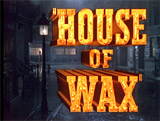
|
House of Wax (1953)
This classic horror film by director Andre de Toth was originally shown in 3-D (it was the first 3D film from a major studio (Warner Brothers)). It was a more expensive remake of their earlier Mystery of the Wax Museum (1933), with Vincent Price establishing himself forever after as the quintessential horror villain:
He struggled with his business partner Matthew Burke (Roy Roberts) over their differing viewpoints on prized wax masterpiece displays in the museum. Burke deliberately set the museum on fire (to successfully claim insurance money of $25,000), and as the building burned around them, they fought each other. Burke fled, but it appeared that Jarrod died as the fiery structure collapsed on him (but no corpse was found).
Months later, a cloaked, disfigured figure was committing murders in NY, including:
After Cathy's friend Sue Allen (Phyllis Kirk) discovered Cathy's corpse in her rooming house bedroom, she was pursued by the menacing cloaked killer through the fog-shrouded streets. Jarrod survived the fiery blaze and appeared about 18 months later (although he claimed: "Jarrod is dead. I am a reincarnation"). His face appeared normal, but he had scarred and useless hands, and he was wheelchair-bound. He was rebuilding a new House of Wax museum, with assistance from deaf-mute sculptor Igor (Charles Bronson) and student-artist Leon Averill (Nedrick Young), that showcased a "Chamber of Horrors" - commemorating famous and fresh "crimes of violence" through wax figures (to give the people what they wanted: "sensation, horror, shock"). In the plot twist, it was revealed that the vengeful Jarrod (in the disguise of the cloaked, face-disfigured killer and later wearing a facial mask to hide his melted face) had been committing the many murders. He then stole their corpses from the New York City Morgue and coated them with molten wax to produce very life-like statues for his waxworks exhibits ("Each subject must be taken from life"). Cathy's body was used as a "model" for the figure of Joan of Arc. Sue was amazed by the likeness: "Why should it be so much like Cathy?" In the surprise ending, and in one of the film's most startling scenes, Jarrod caught Sue after hours in the wax museum. She had suspected all along that the Joan of Arc figure was too real to be just a model - she accused him:
Jarrod (who had faked being crippled) then admitted his hideous and insane plan - to take corpses from the morgue for his wax displays. And she was to be his next "leading lady" for immortality - Marie Antoinette:
Heroine Sue unmasked Jarrod when she beat at his face with her fists - cracking his face mask and revealing his hideously-burned and disfigured visage underneath. She had discovered Jarrod's murderous designs for her - but then fainted. Meanwhile, under intense police detective questioning and pressure, Leon admitted his master's crazy plans ("The whole place is a morgue!"), and the officers rushed to save Sue. Jarrod had taken Sue to his cellar laboratory, where she was strapped and naked under a boiling vat of wax, and was prepared to be his next exhibit.
During a struggle with authorities who arrived at the scene just in time, Jarrod wound up falling into his own burning cauldron of tallow (at over 450 degrees F.) - his apt and richly-deserved fate. |
 Matthew Burke (Roy Roberts)  Professor Henry Jarrod (Vincent Price)  Cloaked, Disfigured Killer  Professor Jarrod With Igor (Charles Bronson)  Sue: "It's Cathy's body under the wax!"  The Unmasking of Professor Jarrod  Sue - Jarrod's New "Marie Antoinette"  Jarrod's Death in His Own Cauldron of Wax |
||||||||||||||||||

|
House on Haunted Hill (1959)
The original horror film with this title was director/producer William Castle's campy and gimmicky House on Haunted Hill (1959) - forty years earlier than its glossy and elaborate remake, House on Haunted Hill (1999). Filled with B-movie shocks and plot twists, the setup was the hosting of a mysterious party by eccentric millionaire Frederick Loren (Vincent Price) for 5 guests and for his fourth wife Annabelle Loren (Carol Ohmart). He had rented the house from drunken wastrel Watson Pritchard (Elisha Cook Jr.), one of the guests and the mansion's owner, who believed that there had been seven inexplicable, brutal murders in the reputedly-haunted house - including beheadings and amputations. In fact, the house did seem spooked, with a falling chandelier, bleeding ceilings, moving walls and secret passageways, a severed head in a suitcase, and 'ghosts.' The other four party guests, who were in desperate need of money, were:
Any of them who survived the 12-hour night in the locked house (after midnight) would receive $10,000. The suicide (by hanging) of Annabelle in the stairwell was faked. She was actually allied with Dr. Trent - the two lovers were both scheming to kill Loren for his fortune. The vengeful Loren had other plans - he faked that he was shot dead in the cellar by one of the guests who was driven to hysteria, young Nora Manning. Dr. Trent went to the wine cellar to dump Frederick's body into an acid vat hidden beneath a large trap-door in the floor. During a 'lights-out' struggle between the two, it sounded like Loren's body was dumped into the vat. [However, it was later revealed that Frederick revived - the gun that shot him had blanks in it - and he had pushed Trent's body into the vat of acid.] Shortly later, Annabelle arrived to search for Trent. From a side room, Loren scared the wits out of Annabelle with an "Emergo" skeleton (she believed it was her vengeful husband Loren's skeleton) that rose and emerged dancing from the vat. The conniving wife was pursued and taunted by the skeleton, using Loren's voice:
She screamed as the skeleton touched her shoulder, backed up in fright, and tumbled into the vat behind her. Loren emerged from the shadows, manipulating the puppet-like skeleton on wires and strings. He offered silky-voiced eulogies for the two deceased:
Loren admitted to his guests that the two had died trying to kill him: "I'm ready for justice to decide whether I'm innocent or guilty." |
 Frederick Loren (Vincent Price) 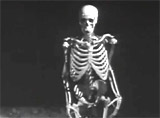  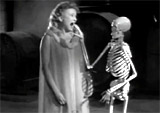 The "Emergo" Skeleton Scare for Wife Annabelle Loren (Carol Ohmart)  Loren Manipulating the Puppet-Skeleton |
||||||||||||||||||

|
The House on 92nd Street (1945)
Director Henry Hathaway's semi-documentary styled, propagandistic 'film noir' was based on a real-life case of espionage-smashing (of a Nazi spy ring) in the early 1940s. It was one of the earliest semi-documentary crime thrillers. In the film's opening, it included the following message:
The opening, over 10 minute narration was delivered by an impressive sounding male voice - with an unabashed positive advertisement for the FBI's mission and work during World War II:
The dramatic, fact-based film was about the "Christopher Case." It told about a group of German Nazi spies in New York City attempting to transmit plans for 'Process 97' (the name for America's top-secret plans for the development of the A-bomb) to Hamburg. Reportedly, the German spy leading the Process 97 project was code-named "Mr. Christopher." The Nazi spies were being infiltrated by the FBI through the coordinated efforts of agent George Briggs (Lloyd Nolan). Their main weapon was a recruited agent:
After infiltrating into the spy ring, Dietrich made contact with German conspirator Colonel Hammersohn (Leo G. Carroll), and the pretty owner of the 92nd Street house headquarters - a dress designer named Elsa Gebhardt (Signe Hasso), who was a German agent posing as a couterier. However, Dietrich had found himself unmasked as an FBI agent, and was injected and drugged by Gebhardt with a solution of scopolamine (in order to get information). As the film was concluding, their headquarters on 92nd Street was surrounded by government agents, and the German spies were given two minutes to surrender. Gebhardt ordered all their papers burned in the fireplace, then said she needed to escape with espionage materials to be sent to Hamburg that evening. Gebhardt removed her blonde wig and makeup and changed into the clothes of a gentleman, just as the apartment was tear-gassed. It was revealed in the film's conclusion that the mysterious, unseen character of master-spy leader "Mr. Christopher" was actually female transvestite spy member Elsa Gebhardt. She escaped from a window in the 92nd Street house and fled down a fire-escape, but then had to retreat back into the apartment. There, she was accidentally shot to death by one of her own men. Dietrich was rescued and the other spies were arrested. The final narration ended with patriotic music and the seal of the FBI under the words "The End.":
|
 William Dietrich (William Eythe)  The Christopher Case  Colonel Hammersohn (Leo G. Carroll)  Elsa Gebhardt (Signe Hasso)  Dietrich Caught by Spies and Drugged   Elsa Removing Blonde Wig and Makeup and Dressing as Man  German Agent Mistakenly Shooting "Elsa"  The Dead "Mr. Christopher" = Cross-Dressing Female Spy Elsa Gebhardt |
||||||||||||||||||
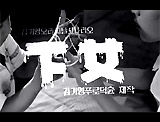
|
The Housemaid (1960, S. Korea) (aka Hanyeo)
Writer/director Ki-young Kim's psychological horror thriller and domestic melodrama was set in post-war Korea. Its themes were marital infidelity and predatory sexual obsession of the title character - the 'housemaid', mixed with a critique of traditional and materialistic bourgeois values. The pre-credits sequence contained the first part of the memorable plot twist: a husband was speaking to his wife while reading a newspaper account about a businessman who committed adultery with a housemaid and brought terrible consequences upon his family:
The dialogue in this scene contained clues to the film's framing device (with a surprise ending) and a premonition of what was about to happen. The opening title credits (with dripping blood in B/W) were superimposed above the unsettling and long game of cat's cradle - metaphorically a web of entanglement played by the couple's two children. The main characters who lived in a claustrophobic, two story western-style, South Korean house were a family of four including:
The family hired unstable, pig-tailed, chain-smoking, "not too bright" textile factory worker Myung-sook (Lee Un-shim) as the family's housemaid, who began behaving unpredictably, erratically, capriciously and strangely -- almost immediately, she chased and caught a rodent with her bare hands in the kitchen and had an unusual smile on her face as she held up its corpse by the tail. She also developed an obsession with rat poison kept in the kitchen cupboard, voyeuristically spied on Kim giving piano lessons through a sliding glass door, taunted the children, and banged on the piano in the middle of the night. After seducing Mr. Kim and becoming pregnant, the housemaid tried to insinuate herself between Mr. Kim and his wife. The scheming Mrs. Kim learned of her husband's infidelity when he confessed to her, and she assured him: "I'll beg the girl on my knees...We can't let our precious lives be destroyed now." Moments later, she suggested that the housemaid throw herself down the tall stairway to induce a miscarriage and abort the baby (the incident was heard off-screen). Jealous of Mrs. Kim's newborn baby son, she threatened to kill it. The stairway was also the scene of the death of the younger son (he had been tricked by the vengeful housemaid into believing he had drunk from a glass of rat-poisoned water), and as he ran to tell his parents, he tripped and fell down the stairway and died at the foot of the stairs. In the film's unforgettable climax (a memorable death scene), the crazed housemaid urged Mr. Kim to commit a double-suicide with her by ingesting rat poison dissolved in glasses of water: ("That'll make the living happy - Die with me! Make me the happiest woman!"). As they were dying from the poison, she gave a deranged speech: ("Don't worry. I'll be with you for eternity. I'll ask God to perform our wedding ceremony. The flowers will never wither, while the paths will glitter with jewels. And nobody will ever take you away from me" - lightning struck). Mr. Kim decided to climb down the stairs to die by his wife's side: ("You can take my body, but not my soul"), but the housemaid resisted his last request: ("If I lose you now, I'll never find you again in heaven"). She grabbed onto his left leg and ankle and was dragged down each step - with her head pounding or thumping into each stair-step - if the poison didn't kill her, a damaging concussion did. When Mr. Kim crawled into his wife's sewing room and collapsed dead at her feet - she was regretful: "Oh, if only I hadn't wanted the new house."
However, the previous series of deaths (from rat poison or from the stairs) were only in the imaginations of the husband and wife. In the stunning and jarring plot twist ending -- the camera pulled back to find both husband and wife alive. The scene returned to the opening pre-credits sequence. The entire 'housemaid' story was a cautionary "what if" tale between the husband and wife:
Suddenly, the sliding door opened, and the housemaid delivered a tray of tea to the family! and then the husband broke the fourth wall and addressed the camera and audience, before ending with a laugh:
|
    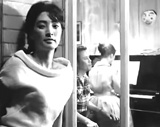  The Seduction The Deadly Stairway:  The Housemaid's Miscarriage  The Younger Son's Death at Foot of Stairs  The Double-Suicide Poisoning    Plot-Twist Ending |
||||||||||||||||||

|
Hush...Hush, Sweet Charlotte (1964)
Producer/director Robert Aldrich's follow-up film (and a sequel of sorts) to Whatever Happened to Baby Jane? (1962) was a gory, suspenseful Southern Gothic crime-horror drama, with many twists and turns. During the film's pre-credits prologue set in 1927 in Louisiana, patriarchal father Samuel Eugene 'Big Sam' Hollis (Victor Buono) chastised John Mayhew (Bruce Dern), the philandering husband of Mrs. Jewel Mayhew (Mary Astor in her last film), for wanting to elope with his young Southern belle daughter Charlotte Hollis (Bette Davis) during a dance the next evening. He vehemently objected to their affair. The first of many graphic and brutal murder scenes occurred next. During the dance, married lover John broke the news to Charlotte that they had to break up. She was devastated by the news, and stomped off: "I could kill you!'. Then, in a graphic and brutal murder scene, John's right hand was severed by a meat cleaver (wielded by an unseen figure seen in dark shadows), and then he was beheaded - blood splattered onto a white marble statue of a cherub (or cupid).
Charlotte returned to the party in progress and walked in with a huge blood stain on the front of her white dress. Her father approached and solemnly told her: "Charlotte, honey, you come with me now....Come with me, baby" before a fadeout. Newspaper headlines from 1927 exclaimed: "GRUESOME MUTILATION MURDER - Parts of Body Missing" Charlotte claimed that she had discovered John's decapitated body in the summer-house gazebo. Although she was the prime murderess suspect and assumed to be the guilty one, she was acquitted. Charlotte feared that her father had killed John (and subsequently he had committed suicide). In 1964, the aging Charlotte was still residing in her childhood bayou home, having turned demented, eccentric, reclusive and sheltered. The deranged Charlotte was cared for by longtime, loyal, white trash housekeeper Velma Cruther (Agnes Moorehead). Charlotte's close childhood cousin Miriam Deering (Olivia de Havilland) was also called to the decaying plantation home to help. Meanwhile, she rekindled a relationship with longtime local family doctor Dr. Drew Bayliss (Joseph Cotten). With their arrival, Charlotte experienced tormented hallucinations and nightly hauntings - she called for "John" at night, heard a harpsichord playing one of John's songs written for her, and experienced sights of Mayhew's disembodied hand and meat cleaver - and his head rolling down the stairs. Velma suspected that Miriam and Drew were conspiring to drug Charlotte to inherit her estate and to drive her insane. She frantically tried to rescue Charlotte and asked: "What's goin' on up there that you don't want me to see?", but Miriam smashed a chair over her head and pushed her down the spiraling staircase to silence Velma's suspicions and interference forever.
Charlotte was tricked into shooting and 'killing' Drew. The two drove off with Drew's corpse in the back seat wrapped in a rug, as Charlotte complained: "Miriam, I can't touch him. Don't make me do it, Miriam." Miriam berated and snarled back at Charlotte: "Get out. Do what I say!" The two rolled the corpse down a hill to bury it in muddy swamp water. As they drove back to the mansion, Charlotte was wimpering - claiming that she couldn't lie to authorities if they found the body and asked her questions. Miriam scolded: "Will you stop that?" Then, Miriam abruptly stopped the car, and repeatedly slapped the cowering Charlotte across the face:
One of the film's plot twists was that Drew (with Miriam's help) had faked his death with blanks in the gun. He 'returned from the dead' in a muddy suit. At the top of the stairs, his muddy feet and trousers left a trail of footprints. To her horror, Charlotte screamed at the sight of Drew, crawled backwards down the stairs, and emitted feral sounds and screams. Another major plot twist was Miriam's revelation to Drew that in 1927, she had witnessed Mrs. Jewel Mayhew murder her own husband, and had been using it as blackmail against Mrs. Mayhew (and Charlotte) for many years. In a climactic sequence, Charlotte overheard Miriam and Drew's plotting, embracing and kissing below. She crushed both of them to death by dropping a huge stone urn with a potted plant onto their heads from the balcony.
In the twisting conclusion, Charlotte was driven away (possibly to be a suspect and charged with murder for a second time). Visiting Englishman Harry Willis (Cecil Kellaway), who was curious about the decades-old murder and was conducting an insurance investigation, handed Charlotte an envelope he had been given earlier by Mrs. Mayhew ("Miss Hollis, this letter's for you. I think you've been waiting a long time for it"). He had personally been instructed not to open it until after Mrs. Mayhew's death. Upon hearing of Miriam's and Drew's deaths the night before, Mrs. Mayhew had suffered her third stroke and died that morning. It contained her written confession that she had murdered her husband. Charlotte was to be vindicated and cleared after so many years. |
  Patriarch Hollis   Charlotte's Blood-Stained Dress  Drew and Miriam   Charlotte's Hauntings: John's Severed Hand and Head      The 'Murder' of Drew and Disposal of His Body  Drew's Muddy Return From the Dead  Twist Conclusion: Mrs. Mayhew's Confessional Letter Given to Charlotte |
||||||||||||||||||